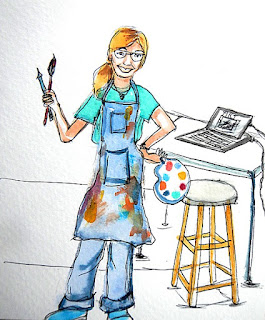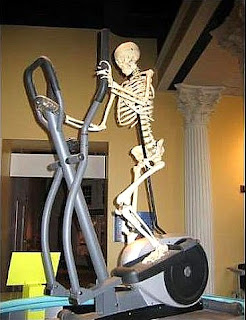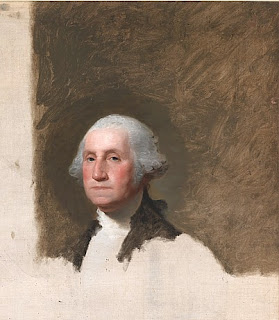 |
| Mistakes or mistreaks? |
 |
| Art and freedom comes from both ends of the pencil. |
I'm a little reluctant to get into a topic like this. It makes me out to be some sort of painting guru who has "been there, done that" insofar as having made every mistake in the book. That's not the case. I've made my share, believe me, but there are still hundreds, perhaps thousands, of mis-takes I
haven't made. Some I've learned to avoid. Others I've just not had
time to make yet. When discussing mis-takes, virtually all of them fall into one of two categories--those made in creating art, and those made after having done so. I'm not going to get into the latter. Virtually all of those involve marketing in one form or another, and though I've had some hands-on experience in this regard, not to mention having read lots about it, I don't feel qualified to go there in the first place, and of the two categories, it's by far the most tedious and boring. My experience, my strengths have always been in the "how to" realm and in this case, the area of "how
not to."
 |
I've taught artist who were not just mistake
prone, but accident prone as well. |
Even in discussing how
not to paint, the discussion breaks down into two fairly distinct areas--bad personal habits, and bad painting habits. The two are closely interrelated but
not inseparable. The first group are often common-sensical, though, as they say, common sense is not all that common. The second group has more to do with what goes on inside the artist's
head rather than what happens with the artist's
hand holding a brush.
Today, I'll deal with bad personal habits.
Tomorrow, bad painting habits. In having taught art for more than twenty-five years, I've seen every one of these mistakes dozens....usually hun-dreds...of times. And don't get the idea only beginning artists or amateur artist make such mistakes. I've seen many professionals, including myself, fall victim to such errors. Sometimes I'm even
shocked to see those who, by rights,
should know better, prove that, in fact, they
don't. The thing to remember is that as artists progress and mature, they tend to make
fewer mistakes; but never do they get to the point of making
no mistakes.
 |
| Science has put off looking for a cure. |
1. At the top of the list, and far and away the worst mistake an artist can make in painting a picture, is in
not painting it. In my book,
Art THINK (available at right) I refer to this as the "P" word--procrastination. There are dozens of trite prescriptions aimed at curing this ailment. And, in fact, it IS much more closely related to a mental illness than a bad habit. We all have symptoms from time to time. If they become chronic, or acute, the artist is literally dead in the water.
Ideas are not art. If procrastination prevents them from getting outside the brain, no art gets produced; no other mistakes are made. The artist dies, or at least ceases to
be an artist.
 |
| Self-taught versus classroom instruction |
2. Teaching oneself. I know, some fairly famous and successful artists have done so; but thousands more have
tried to do so and failed miserably. In any educational pursuit, the mantra is, "learn the basics," but in art (and probably all other areas as well) there's far more to it than that. Starting a car and not killing oneself and others in driving it--that's the basics. There are refinement far beyond the basics one can
only learn through extended personal experience stretching over hundreds of paintings, OR by absorbing the teachings of a trained professional skilled in imparting such extended experience in small, simple, repetitive, and very numerous doses. Taking art classes costs money (for both instruction and supplies), while also demanding self-discipline. If you lack either, forget about becoming an artist.
 |
| Just before he sets up his easel to paint his back yard. |
3. Trying to be perfect. In other words, make mistakes. Without mistakes, learning from them is impossible. One of the most frustrating experiences an art instructor can encounter is trying to teach a perfectionist. Some people, in fact, give perfection a bad name. In any case, perfectionists seldom complete much artwork; and even when they do, they often hate the results: "It's not quite right." Learn to recognize mistakes and learn how to correct them, but also learn that
some mistakes are too
major to correct, while at the same time, too
minor to worry about. Let them go. Move on. Learn what
not to do from them.
 |
| Art need not be a lonely pursuit. |
4. Working alone. Despite what I just said about taking art classes, I've learned far more from other artists, some with far less experience than myself (even from my students), than I have
ever learned from art instructors. Of course the two go hand in hand. You will seldom meet or get to know other artists outside a classroom setting. In any case, learning from others takes time. A brief conversation with another artist at an art show in insufficient to obtain the interactive feedback and inspiration one gets from others in a classroom or club-like setting. Plus, a class has only
one instructor, but many teaching assistants...like yourself.
 |
| For occasional use only--a reference, not a source. |
5. Relying on a visual dictionary. The visual dictionary resides in the left hemisphere of the brain, helping us to recognize and discern the difference between a hand and a foot. One of the biggest handicaps an artist encounters is in
not letting go of this visual history to really LOOK at the hand or foot you want to draw. We see hands and feet daily. Thus we have a tendency to make assumptions when drawing them. Let the intuitive, right side of the brain rule in drawing. Look, draw, look, draw, look, draw. Nowhere in that routine does it say "think." Nowhere does it say "recall" or
"interpret." Drawing from life is all guesswork. "I
guess that's how it should look." "I
guess it would look better if I made the toes longer." Guessing does
not involve "counting the toes first."
 |
| Paint what you know, but know what you paint. |
6. Skipping homework. No conscien-tious artist-parent would let their kids get by ignoring homework assign-ments. Just as you wouldn't try changing the oil in your car not know where the dipstick is, neither should you try painting roses without having studied your subject matter. I men-tioned above not letting go of your "visual dictionary" but that does
not mean you refuse to own one. You can draw a rose simply by looking at it and thinking it's a tulip, but the result will be neither a good rose nor a good tulip. The more complex your subject be-comes, the more absolutely vital becomes the absorption of the back-ground understanding of that content. Think of your visual dictionary as a reference book--a rule of thumb, not a bible.
 |
| All things in moderation--even art. |
7. Knowing when to stop. Everyone who creates something is guilty of this. When you step back from your nearly completed painting, you will inevitably notice that spots where the color is weak, a section with a bit of canvas showing through, a tree lacking a bit of foliage. By all means, correct simple, glaring errors. But if you let yourself get drawn in to painstaking examination of everything you do, you'll never be finish
any of it. Quit while you're ahead. An overworked painting is just as bad as one obviously unfinished...and to some eyes, far worse. There's an old saying, "It takes three people to create a portrait, the artist, the model, and someone to clobber then artist when he or she is finished."
 |
Stuart's unfinished painting of Washington
the most famous unfinished work in the world. |
8. Unfinished work. You wouldn't take a college course, attending class faithfully for ten to twelve weeks, then not show up for the final. Yet some artists, in effect, do just that when it comes to painting. They make a decent start, get perhaps half-way through, then, unaccountably lose interest and quit. This is the opposite of not knowing when to stop--stopping way too soon. As a former art instructor, believe me I know, even adults have varying attention spans. Some students feel that if they don't complete a painting in a single sitting or a single class session, then to hell with it. It's for such people that God gave us acrylics. The artist severely lacking in persistence is tantamount to one lacking eyes.
 |
| Fearing the new, rather than embracing it. |
9. Fearing to move on. As with a physical workout, when starting out, it’s important to stretch your drawing muscles. Push yourself. Take risks. Don’t limit yourself to a particular set of subjects – only drawing landscapes or flowers, for instance. Don't become infatuated with a particular style of drawing, or even to a single medium. That's how you discover hidden talents and find you like drawing things you never thought you would. Coupled with this is the fear of starting a new painting. I've seen students literally
paralyzed creatively, by indecision and fear of failure. This is especially true if a student has had some surprising success with one or more early works. The thinking goes, "I've painted a pretty good horse or two so therefore I can only paint horses, and only
standing horses...preferably looking
away from the viewer."
 |
Copyright, Jim Lane
An artist copying a painting in the Louvre. The Louvre hires the artist and sells the copy to other museums.
|
10. Imitating others. Pursue
inspiration, not
imitation. Unless you plan to become a professional art forger, you need to seek your own style and perspective...build your own boat then row it, so to speak. In the past, many artists have tried to learn painting by sitting up their easels in museums and copying famous masterpieces. That method of learning is now so antiquated as to be comparable to painting outside so as to observe the growing of grass. Study the work of artists you admire, online or in books, but don't spend a lot of time trying to draw or paint like them. By all means, choose favorites, and learn from them, but
adapt what you learn to your own unique style and process...don't copy. Copying is the antithesis of creation...it's re-creation, or at best, art recreation.
 |
| Art recreation |














No comments:
Post a Comment